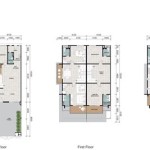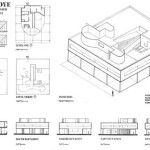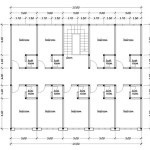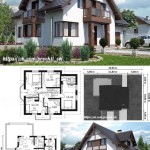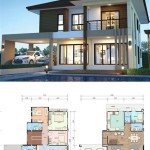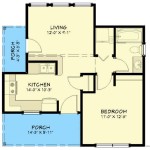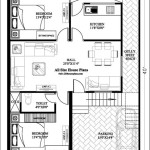Modern Dogtrot House Floor Plans: Bridging Tradition and Contemporary Living
The dogtrot house, also known as a breezeway house, holds a significant place in American architectural history, particularly in the Southeastern United States. Characterized by a central, open breezeway separating two enclosed living spaces, the dogtrot design served as a practical solution for natural ventilation in hot and humid climates. Modern dogtrot house floor plans retain the essence of this historical design while incorporating contemporary aesthetics, materials, and functionalities to meet the demands of modern living.
The core principle behind the dogtrot design remains the same: to create a well-ventilated and comfortable living space. However, modern interpretations often expand upon the traditional blueprint, incorporating larger living areas, updated amenities, and a greater focus on integrating indoor and outdoor spaces. This article will explore the key elements of modern dogtrot house floor plans, highlighting the benefits and considerations involved in choosing this unique architectural style.
Key Feature: The Breezeway as a Versatile Living Space
The open breezeway is the defining characteristic of any dogtrot house. In the past, this open space served primarily as a shaded area for escaping the heat and allowing breezes to pass through the structure. Modern dogtrot designs elevate the breezeway to a more versatile and functional space.
Instead of merely being a passive corridor, the modern breezeway can be transformed into an outdoor living room, dining area, or even a sheltered playroom. The use of comfortable seating, outdoor lighting, and weather-resistant furniture can create an inviting and functional extension of the interior living space. Some designs incorporate fireplaces or outdoor kitchens within the breezeway, further enhancing its usability throughout the year.
The breezeway also functions as a natural conduit for light and air. Large windows or glass doors on either side of the breezeway allow natural light to flood into the adjoining rooms, reducing the need for artificial lighting. The open design promotes cross-ventilation, reducing reliance on air conditioning and contributing to energy efficiency. The orientation of the breezeway is crucial to its effectiveness, with designs often prioritizing a north-south axis to capture prevailing winds.
Furthermore, the breezeway visually connects the two distinct sections of the house, creating a sense of spaciousness and cohesion. This connection can be enhanced through the use of consistent flooring materials, matching architectural details, and a shared aesthetic throughout the interior and exterior spaces. The breezeway serves as a focal point, inviting residents and guests to appreciate the beauty of the natural surroundings.
Adaptations for Modern Living: Floor Plan Flexibility and Functionality
While the traditional dogtrot house typically features two distinct living areas flanking the breezeway, modern designs offer greater flexibility in floor plan layout and functionality. The two sections of the house can be adapted to accommodate various needs, such as separate living and sleeping quarters, a dedicated home office, or a guest suite.
One common adaptation involves designating one section of the house as the primary living area, including the kitchen, dining room, and living room, while the other section houses the bedrooms and bathrooms. This separation of living and sleeping spaces creates a more peaceful and private environment for residents. Alternatively, one section can be designed as a self-contained guest suite with its own entrance, living area, bedroom, and bathroom, providing privacy for both residents and guests.
Modern dogtrot floor plans often incorporate open-concept layouts within each section of the house, maximizing the use of space and promoting social interaction. The kitchen, dining room, and living room can flow seamlessly into one another, creating a large and versatile living area. High ceilings and large windows further enhance the sense of spaciousness and light.
The adaptability of the dogtrot design extends to the exterior as well. The breezeway can be enclosed with screens or glass panels to create a screened porch or sunroom, providing protection from insects and the elements while still maintaining a connection to the outdoors. The two sections of the house can be connected by decks or patios, creating additional outdoor living spaces. The overall design can be tailored to the specific needs and preferences of the homeowner, ensuring a comfortable and functional living environment.
Energy efficiency is also a key consideration in modern dogtrot house floor plans. The orientation of the house, the size and placement of windows, and the choice of building materials can all contribute to energy savings. Passive solar design principles can be incorporated to maximize solar gain in the winter and minimize heat gain in the summer. High-performance insulation, energy-efficient windows, and sustainable building materials can further reduce the environmental impact of the house.
Materiality and Aesthetics: Blending Tradition with Contemporary Design
Modern dogtrot houses embrace a wide range of materials and aesthetics, blending traditional elements with contemporary design trends. While the traditional dogtrot house often features simple, rustic materials such as wood and stone, modern designs can incorporate a variety of materials, including concrete, steel, and glass.
The choice of materials can significantly impact the overall aesthetic of the house. Wood siding, for example, can create a warm and inviting atmosphere, while concrete siding can offer a more modern and industrial look. The use of natural materials, such as wood flooring and stone accents, can create a connection to the natural surroundings.
Contemporary dogtrot designs often incorporate clean lines, minimalist details, and large windows to create a sense of openness and light. The use of neutral colors, such as white, gray, and beige, can create a calming and sophisticated atmosphere. Accent colors can be used to add pops of personality and visual interest.
The integration of indoor and outdoor spaces is a key element of modern dogtrot aesthetics. Large windows and sliding glass doors can blur the lines between the interior and exterior, creating a seamless transition between the two. Outdoor living spaces, such as decks and patios, can be designed to complement the interior design, creating a cohesive and harmonious living environment.
Sustainable design principles are often incorporated into the material selection process. The use of recycled materials, locally sourced materials, and low-VOC paints and finishes can reduce the environmental impact of the house. Energy-efficient appliances and fixtures can further contribute to sustainability.
In conclusion, modern dogtrot house floor plans offer a unique and versatile approach to residential design. By retaining the core principles of natural ventilation and indoor-outdoor connection while incorporating contemporary materials, aesthetics, and functionalities, these designs provide a comfortable, sustainable, and visually appealing living environment. The adaptability of the dogtrot design allows for customization to meet the specific needs and preferences of the homeowner, making it a timeless and relevant architectural style for modern living.

Dogtrot House Plan Southern Living Plans

Camp Creek Dog Trot House Plan Max Fulbright Designs

Plan 777029mtl 2300 Square Foot Dog Trot House

Diana S Dog Trot Cabin Max Fulbright Designs

Camp Creek Dog Trot House Plan Max Fulbright Designs

Plan 623096dj Modern Farmhouse With Dogtrot And 5 Bedrooms

Plan 92318mx 3 Bedroom Dogtrot House 1112 Sq Ft

Plan 130033lls Waterfront Dogtrot House With Great Outdoor Spaces

Camp Creek Dog Trot House Plan Max Fulbright Designs

Plan 92318mx 3 Bedroom Dogtrot House 1112 Sq Ft

